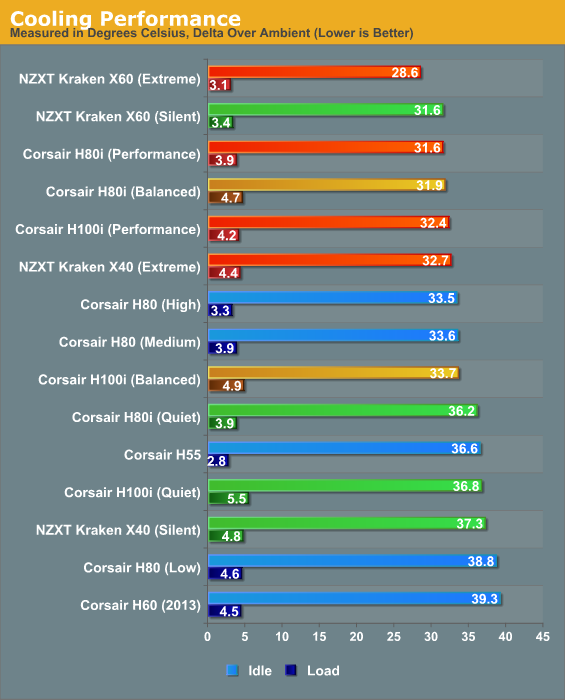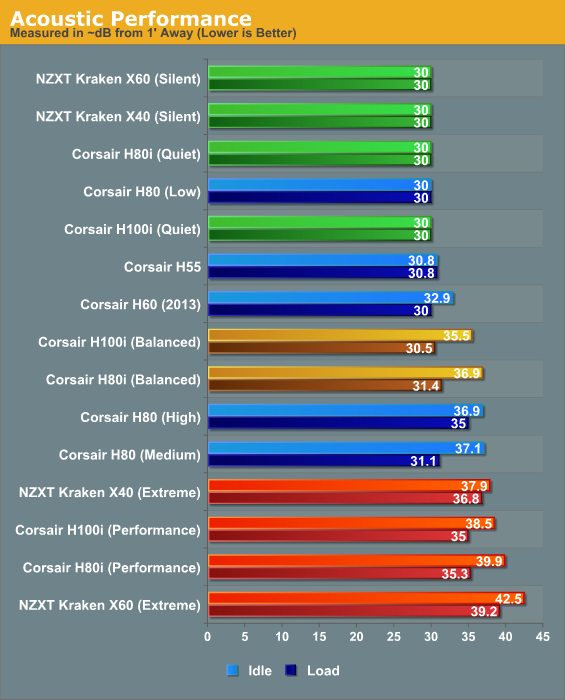Closing the Loop: Contained Liquid-Coolers from Corsair and NZXT Compared
by Dustin Sklavos on December 26, 2012 12:01 AM ESTPerformance Results
Going into testing, it's pretty easy to expect how the coolers should ultimately stack up: Corsair's H55 should be last, followed by the H60, the H80, the H80i, the NZXT Kraken X40, the H100i, and then the NZXT Kraken X60 at the top of the list. The X40 and H80i should compete pretty closely; the X40 has a larger surface, but the H80i has a thicker radiator and a second fan. Corsair's also been happy to advertise that these "2013" radiator fans are based on their successful SP120 radiator fans, which makes sense. We found the Silent SP120 to be pretty solid while the Performance model was at the top of its game if noise was a non-issue.
Keep in mind, though, NZXT's stock radiator fan did surprisingly well in our testing too.
So how did these systems turn out?

Surprisingly, two early favorites turn out to be major underperformers: the Corsair H100i for some odd reason is consistently worse than the H80i (and I did retest to confirm), while the Kraken X40 needs to run at full bore to produce decent results. Meanwhile, the H55 with its constant fan speed actually manages to best the new H60 (though PWM control may certainly contribute to that).
So where are the big winners? While the H80i is pricy, it does perform notably better than its predecessor, producing better thermals at a lower setting. And the most expensive system of all at least earns its price tag; the NZXT Kraken X60 turns out to be every bit the cooling monster the rep promised it would be, meeting or beating every other cooler at its lowest setting.

As far as noise is concerned, the X60 is once again at the top of the pack. Note that our sound meter doesn't go below 30dB and the X60 is noticeably louder than the X40, but not by much and not enough to really change the way things turn out.
So how do noise profiles change the standings? The X60 excels in both disciplines and is essentially undefeated, but the Corsair H55 makes a good case for itself. Thermal performance isn't fantastic, but it's quieter than the H60 under load while running cooler. Meanwhile the H80i remains basically the best offering in Corsair's lineup, running slightly cooler and quieter than the single-fan Kraken X40.










68 Comments
View All Comments
Death666Angel - Friday, December 28, 2012 - link
Maybe different people need different things? The big heatsinks that can compete with these watercoolers usually weigh a lot, restrict access to other components and stress the mounting system. Some also don't fit in all cases because of the width of the case being too shallow (my Scythe Mugen 2 did not fit without the sides of the case bulging out) or they don't fit with certain RAM modules or motherboard coolers.Also, is your heatsink/fan really silent or just silent enough for you? How are the temperatures? Some people like having their CPU under 50°C, others are fine with 90°C. With a better heatsink, could you get higher clocks our of it? I know I could go from 3.3GHz (i7 860) to 3.8GHz stable with my watercooling setup (non-AIO).
Also, no one if forcing you to buy these coolers to replace yours....
And lastly, do you _know_ that these radiators are more surface than a high end aircooler? Because current day tower coolers that may use 2 140mm fans have a lot of surface and my guess is they are at least equal to these higher end watercoolers.
HutchinsonJC - Wednesday, December 26, 2012 - link
Where is the original h100 on the graphs?Why are there so many colors on the graphs? The legend shows a dark blue and a light blue, yet there is red, orange, and green in the charts with no seeming rhyme or reason.
ypsylon - Wednesday, December 26, 2012 - link
It is the problem of all these AIO kits. Mixing aluminum radiator with copper block = degraded performance over time (it is just chemistry cold and unsympathetic). And it is impossible to replace radiator without voiding warranty. Also performance for the price is not exactly top notch. One of the reasons why custom (well big word as you can buy pre-prepared kits and mount everything in the box without any customization actually ;) ) loops more expensive. Copper is expensive and performance always cost. Of course there is 100% difference between H100i and cheapest 240 pre-prepared kit from example EK or XSPC. But over time performance and fully modular setup is well worth extra $$$. Simple as that.As I see it, AIO have only one advantage over air cooling, and that is you don't need behemoths like Phantex/Noctua/Thermalright dual-tower coolers. All of them are extremely heavy, able to deform the board/cpu socket/ memory banks circuitry (like on s1366 which was fairly common) or break it completely. One of the areas where big is not exactly best.
rrohbeck - Wednesday, December 26, 2012 - link
I'd like to see some of the better air coolers on the chart. In the few tests that had both, the top end air coolers generally were in the vicinity of the H100.Hood6558 - Wednesday, December 26, 2012 - link
Very good article, and highly relevant to those of us awaiting availability of the Krakens. Nice to see that they're apparently worth upgrading to, if only for 3 or 4 degrees at load, every little bit helps. Disappointed in the H100i numbers (I'm currently running an H100), how did they lose performance by going with bigger hoses, improved waterblock & pump, and supposedly better fans? Because in all previous reviews, the H100 was champ or at least in top 3. One Point to Corsair for more mature software. Now the big question is, do the NZXT offerings have more clearance issues due to their wider rads - the answer being "of course they do". My H100 in my Carbide 400R just barely clears the VRM heatsink with just 2 fans (I mounted the "pull" fans outside the case) and you have to remove fans to access the CPU fan headers. Of course, that's using the stock centered mounting holes - it's possible to mount the rad offset by lining up some of the holes in the honeycomb with mounting holes - not possible with 140mm rads. I'm pretty sure that in my case, it will hit the heatsinks unless I drill holes and mount as far to the left of center as possible.mayankleoboy1 - Wednesday, December 26, 2012 - link
Why not use a Ivy bridge CPU ? At 4.5 GHZ, and 1.3V, they get very hot very quickly.vanwazltoff - Wednesday, December 26, 2012 - link
i would really like to see how these closed loops compare to the incoming cooler master eisbergjonyah - Wednesday, December 26, 2012 - link
I think money is well spent on a closed loop water cooler. The less stress on the MB, great cooling performance (on par with equally priced heatsink/fans) and low noise level is definitely worth it. If you're putting in a $300+ cpu, it makes sense to take care of it. I've had the H60 for 12 months now and it has performed flawlessly. If you compare it's cooling to the stock cooler it came with (complete crap), it's incredible.I think the article would be better served to include benchmarks of non-water coolers to show how great these really are. I was running in the 70+C range with the stock cooler while pushing it, and now can't push my chip above mid 40's. That alone will keep my chip lasting a lot longer (though I'm probably going to be upgrading it soon).
A5 - Thursday, December 27, 2012 - link
Stock coolers are garbage, everyone knows that. But a $70 air cooler would outperform the H60.vectorm12 - Wednesday, December 26, 2012 - link
Thanks for all your hard work Dustin.As some have already pointed out there's little difference in performance of these coolers and the traditional Aircoolers. However what I&ve been dying to find out all this time is how much internal temps is reduced by the direct exhaust of these kits?
If they are efficient enough it should allow a case to support more TDP in the form of GPUs, Raid-controllers and HDDs. I've also always wondered what happens to the airflow around VRMs and DIMMs when the fan at the socket is transplated. Of course different cases will result in different results but it's still something I'd consider worth looking into.
In a future review I'd very much like to see some values relating to the temps of motherboard,DIMMs, VRMs and so on as well as the effects of transplanting the CPU-fan